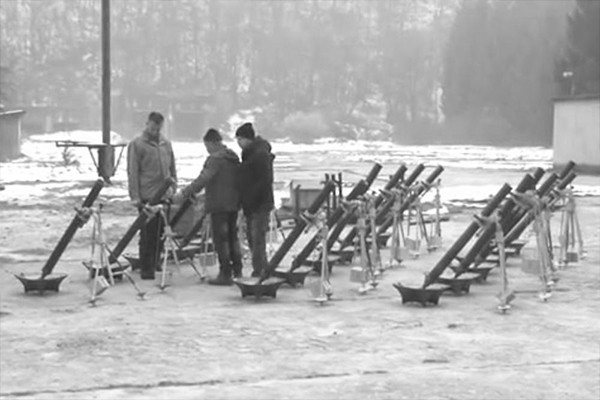An article published in the British “Independent” started an avalanche of claims that Bosnia and Herzegovina is “arming terrorists”.

In May 2018, we wrote about the stories that “BiH is arming terrorists” in the analysis titled “Where we export and do not export weapons”. Bosnia and Herzegovina was once again in the spotlight when the Independent published an article by Robert Fisk, a journalist who found “documents” in Syria of weapons produced in BiH, Serbia, Bulgaria and the United States.
In the original article, the Independent published supporting documents (not the weapon certificates, as many claim) on a 120-mm mortar manufactured in BiH; instructions for two “Zastava” machine guns (COYOTE M02 and M84); a delivery note for artillery ammunition from Bulgaria, and empty boxes of anti-tank weapons produced by the Hughes Aircraft Company of California. Fisk states that he found these documents at three different locations in Aleppo in February 2017:
“In the weeks following the December surrender of fighters in eastern Aleppo, the ruins were full of mines and landmines. Entire neighborhoods were still cordoned off when I entered three former Islamist group barracks in February 2017 (…). of these, I found piles of discarded documents with instructions for machine guns and mortars, all in English.
Among them were export documents and instructions for the use of weapons from Bosnia and Herzegovina and Serbia, whose pages were still wet from the winter rains, and some of them were soiled with shoe prints. I packed everything that could fit in a bag, and later I found – in another building – documents for artillery ammunition from Bulgaria. Deep in the basement of the third building in the Ansari district, where the words of Jaish al-Mujaheddin (Army of the Holy Warriors) could still be seen, lay dozens of empty boxes containing anti-tank weapons, with the manufacturer’s name – “Hughes Aircraft Company” from California. The boxes were marked “Guided Missile Surface Attack” with numbers beginning with the computer code “1410-01-300-0254”.
Nowhere in his article did Fisk claim that “500 mortars from BiH ended up in the hands of terrorists”, but such claims appeared in some media that reported his allegations, some less, and some more explicitly:
Five hundred mortars from BiH ended up in the hands of ISIL militants (more media)
British journalist reveals: How 500 mortars from a factory in Bosnia ended up with ISLAMIC EXTREMISTS (Blic)
At least 500 120-millimeter mortars, manufactured at the BNT-TMiH factory in Novi Travnik, Federation of BiH, ended up in 2016 with Islamic State extremists and Al Qaeda in Syria, during the fiercest clashes in the country between radical extremists and Syrian-controlled forces. President Bashar al-Assad. (Vesti/RTRS)
The paper reveals that weapons produced at Novi Travnik Machinery and Hydraulics Factory were sold to Saudi Arabia in January 2016, and that their journalist found certificates for about 500 mortars in the basement of a bombed al Qaeda weapons depot in eastern Aleppo. (ATV BL)
The weapons produced in the BiH factory “BNT-TMiH”, which were sold to Saudi Arabia, ended up in the hands of extremists of the Islamic State and Al Qaeda who fought against Syrian President Bashar al-Assad, writes the British “Independent”. As it is stated, it is about 500 mortars from this factory. (more media)
The latest case with the discovery of 500 mortars in Syrian Aleppo, manufactured in Novi Travnik, which, according to the British “Independent”, were in the hands of terrorists of the Al Nusra Front, according to the interlocutor of “EuroBlic”, raises numerous questions. (Blic/Srpska info)
The number of 500 mortars was taken from a statement given to Fisk by Ifet Krnjic, who signed documents to export mortars produced at the BNT-TMiH weapons factory in Novi Travnik. Krnjic, however, made it clear that the shipment was – legally – exported to Saudi Arabia. Neither Krnjic nor Fisk hinted in any way that “documents” for all 500 mortars were found in Syria, nor does the original article claim that this is the amount of weapons produced in BiH that reached Syria. The document presented the Independent’s text refers to one weapon item, not 500.
“It’s my signature” Yes, it’s me! ” Krnjic confirmed loudly. “It’s a guarantee for a 120-millimeter mortar – it’s a NATO standard. The shipment went to Saudi Arabia. It’s part of a shipment of 500 mortars”.
A similar statement was given by the general director of Kragujevac-based “Zastava” Milojko Brzakovic. Brzakovic also confirmed to Fisk that these are weapons produced in his factory, and which were exported to Saudi Arabia and the United Arab Emirates, commenting that “there is not a single country in the Middle East that has not bought weapons from ‘Zastava’ in the last 15 years”.
Both, therefore, confirmed that the weapons were legally exported and that there was no way to control what would happen to them next. The original article, published in the Independent, states:
Like Krnjic, Brzakovic from Serbia says his weapons factory must obtain an internationally recognized end-user certificate for each shipment of weapons – but agrees that exporters have no obligation or mechanism to prevent further delivery of their weapons to third parties after it reaches its original destination.
However, although exporters from BiH and Serbia gave almost identical statements about the origin and movement of weapons after export, they received significantly different treatment in the regional media. Kurir, for example, pointed out in the title that “weapons from the Federation of BiH ended up in the hands of terrorists of the Islamic State and Al Qaeda”, while the same media wrote about weapons from Serbia in the following way:
SERBIA WAS SELLING LEGALLY
Fisk writes that he showed the instructions for using weapons found in Aleppo – including the Coyote MO2 machine gun, to 20 foreigners of the Kragujevac factory “Zastava Oruzje” to General Director Milojko Brzakovic. He confirmed that that factory issued the documents and that Saudi Arabia and the United Arab Emirates were among the buyers.
“There is not a single country in the Middle East that has not bought weapons from Zastava in the last 15 years”, Brzakovic said.
In a similar manner, the media in the region pointed out in the headlines that “weapons from BiH” were found in Syria, ignoring the fact that Fisk’s article also talks about weapons or ammunition produced in three other countries – Serbia, Bulgaria and the United States:
Bosnia and Herzegovina is once again at the center of an international scandal. According to the discovery of the British newspaper Independent, the weapons produced in the factory in Novi Travnik, ended up in the hands of jihadists of the Islamic State and Al Qaeda who fought on the Syrian battlefield. (Vecernji list)
In many articles, weapons from the USA and ammunition from Bulgaria are not even mentioned, while data on weapons from Serbia are mentioned in passing, almost as a footnote.
Some went a step further, offering selectively presented information as “proof” that BiH is directly arming terrorist groups in the Middle East:
That’s my signature! Proof that Bosnia is arming DAES (Sputnik)
BiH arms Islamic State and Al Qaeda extremists with mortars (Alternative television)
Mortars from BiH for jihadists (RTRS/Alternative television)
To make the irony even bigger, several articles presenting the whole story as a “scandal centered on BiH”, cite information from the BIRN and OCCRP research networks that BiH is the seventh-largest weapon exporter to the Middle East, Croatia takes the first place, and Serbia is the third. All this did not prevent many websites, newspapers and television from pointing out in their reports exclusively the fact that a document of (one) mortar produced in Novi Travnik was found in an abandoned al-Qaeda warehouse.
Claims that 500 mortars from BiH were found in Syria, which are a misinterpretation of Ifet Krnjic’s statement; as well as claims that the Independent’s article is “proof that BiH is arming terrorists”, we rate as disinformation. We also rate the reports of the media from the region, which treated the information on weapons produced in BiH unequally in relation to weapons produced in other countries that were found in the same warehouse, as biased reporting.
Note: 12/24/2020
After publishing our analysis, the website Kurir published a correction in the article, which is why it received a grade corrected.
(Author: Tijana Cvjetićanin, Raskrinkavanje.ba)
